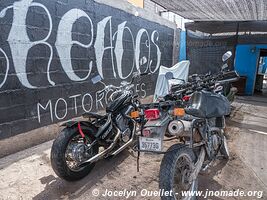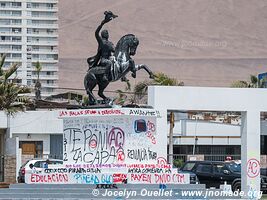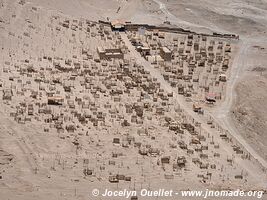Iquique to Pisagua
With the bikers
Following the breakdown of my motorbike in the Huasco salt flat, members of the group offered me to stay a few days in their bunker. One of theirs, with a good knowledge of mechanics, will come to help me fix the bike.
I am at the 'Cabreados' club of Iquique, one of the several groups in the area. The group is organized with a leader, rules, a bunker, and also their own patch to identify the club. There are several clubs in the city, and they all are friendly; all this is a pastime to enjoy life a bit more.
The day of my arrival, there was a party with several members of the group; lots of food cooked on the barbecue, lots of beers and rum, everybody is smoking, and there is the music obviously. I got there during a week with many birthdays to celebrate.
We are now in the house of Pablo and his wife (the pair on the left; Pablo has his thumb up and a watch). Pablo wanted me to taste a typical meal of Chile, the curanto. The dish originates from the Chiloé area, but it has now spread all over the country. On the picture, Sergio can be seen on the right; he is the mechanic that helped me repair the bike.
Curanto is an excellent mix of seafood and meat cooked in a pot with white wine. However, there are several other variations to this dish. It was a very enjoyable evening.
Here is the solution to the problem of the broken screw on the oil filter cover. I found it on the site Advrider.com and the author of this fix and the photos is ER70S-2.
In short, it is possible to install a longer screw or stud than the original one used by Suzuki. Thus, even if the threads on the engine are partly gone, there are still enough left.
Instead of using a new screw, it is recommended to install a fixed stud with blue Locktite (some sort of heat-resistant glue). A nut is used to hold the cover on the engine; in my case, I left enough space to use two stacked nuts. That way, the threads won't be damaged by excess force after repetitive use of the screw by a mechanic or by me. Obviously, don't overtighten the nuts either...
I got help from Sergio in order to get tools, and he was also kind enough to go to the market to buy the required parts. I thank him for his help.
On my motorbike, I replaced only the faulty screw, but I prepared extra spare studs and nuts just in case the other screws also end up damaged like the first one.
Iquique
Iquique is one of the large cities in the deep Atacama Desert. It is surrounded by cliffs and the desert on one side, and the Pacific Ocean on the other side. With its 200,000 inhabitants, the city seems to have reached the maximum of its expansion in this inhospitable corner of the country.
The city was founded in the 16th century, and it was originally part of Peru. Indeed, the War of the Pacific (1879-1884) between Chile, Peru, and Bolivia changed the borders for these three countries. Bolivia and Peru both lost large extent of coastal land. Chile got about 200,000 km2 of new territory, which corresponds to a stretch of land of about 600 km.
Iquique had its share of misfortunes with the earthquakes of 1868, 1877, 2005, and 2014. The one in 2014 had a magnitude of 8.2 and its epicentre was only 95 km northwest of the city.
As for Arica, there are still recurring protests from the Chilean people that strive to get a better life. Damages can be seen in many places over the city.
El Gigante de Tarapacá
The origin of the 86-metre Tarapacá Giant is still a mystery. Some legends say that the geoglyph represents a creator god.
This god made an epic journey from Lake Titicaca to come to die in the Pacific Ocean, and to eventually be reborn in time of crisis. During his crossing, he gave the knowledge of agriculture to the community he met along the way.
Batalla de Dolores
Looking for a campsite on a secondary road, I randomly stumbled upon this historic site. This location was witness to an important battle during the War of the Pacific (1879-1884), the same war I mentioned above in this post.
The battle of Dolores took place on November 29, 1879. It opposed Chile and the Peruvian-Bolivian allied forces. The Chilean successfully repelled the allied forces...
Nowadays, not much can be seen except for a few crumbling walls and some old artefacts found by visitors over the years.
Tilviche Canyon Geoglyphs
These geoglyphs date from the 10th century.
It represents a herd of llamas and a shepherd.
Pisagua
Pisagua is a small village located 120 kilometres north of Iquique. Nowadays, the village is only a ghost of its former self; there are only 260 inhabitants living on fishing. The inhabited buildings are old and in bad shape while many of them are in ruins.
The village is a long way from the time when it was one of the largest Chilean ports. Nitrate used in fertilizers and explosives was the main product transiting through this place at the end of the 19th century.
This curious cemetery with several dozen graves is found only 3 kilometres north of Pisagua. There are also two columbaria.
It is fascinating to discover that most tombs are surrounded by a fence built with what looks like old baby beds, or else from balcony parapets.
Everything is made of wood... It's the extreme desert around here; there are hundreds of kilometres of arid land without any forest in three directions, and the infinite ocean on the other one. Where all the wood came from, and at what cost?




























































































